Sahara: Difference between revisions
m Reverted edits by 64.26.121.118 to last revision by Fieldday-sunday (HG) |
|||
| Line 210: | Line 210: | ||
==Notes== |
==Notes== |
||
{{reflist|2}} |
{{reflist|2}} |
||
I hate you fat trick |
|||
==External links== |
==External links== |
||
Revision as of 13:16, 20 May 2009
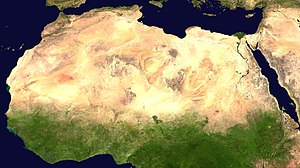

The Sahara (Arabic: الصحراء الكبرى, aṣ-ṣaḥrā´ al-kubra, "The Greatest Desert") is the world's largest hot desert. At over 9,000,000 square kilometers (3,500,000 sq mi), it covers most of Northern Africa, making it almost as large as the United States or the continent of Europe. The desert stretches from the Red Sea, including parts of the Mediterranean coasts, to the outskirts of the Atlantic Ocean. To the south, it is delimited by the Sahel: a belt of semi-arid tropical savanna that comprises the northern region of central and western Sub-Saharan Africa.
The Sahara has an intermittent history that may go back as much as 3 million years.[1] Some of the sand dunes can reach 180 meters (600 ft) in height.[2] The name comes from the Arabic word for desert: (صَحراء), "ṣaḥrā´" ().[3][4]
Overview
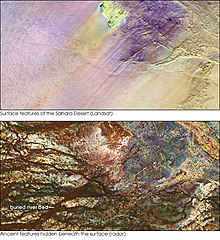
The Sahara's boundaries are the Atlantic Ocean on the west, the Atlas Mountains and the Mediterranean Sea on the north, the Red Sea and Egypt on the east, and the Sudan and the valley of the Niger River on the south. The Sahara is divided into western Sahara, the central Ahaggar Mountains, the Tibesti Mountains, the Aïr Mountains (a region of desert mountains and high plateaus), Ténéré desert and the Libyan desert (the most arid region). The highest peak in the Sahara is Emi Koussi (3,415 m (11,204 ft)*) in the Tibesti Mountains in northern Chad.
The Sahara divides the continent of Africa into North and Sub-Saharan Africa. The southern border of the Sahara is marked by a band of semiarid savanna called the Sahel; south of the Sahel lies the lusher Sudan and the Congo River Basin. Most of the Sahara consists of rocky hamada; ergs (large sand dunes) form only a minor part.
People lived on the edge of the desert thousands of years ago[5] since the last ice age. The Sahara was then a much wetter place than it is today. Over 30,000 petroglyphs of river animals such as crocodiles [6] survive, with half found in the Tassili n'Ajjer in southeast Algeria. Fossils of dinosaurs, including Afrovenator, Jobaria and Ouranosaurus, have also been found here. The modern Sahara, though, is not lush in vegetation, except in the Nile Valley, at a few oases, and in the northern highlands, where Mediterranean plants such as the olive tree are found to grow. The region has been this way since about 5000 BP. Some 2.5 million people currently live in the Sahara, most of these in Egypt, Mauritania, Morocco and Algeria. Dominant ethnicities in the Sahara are various Berber groups including Tuareg tribes, various Arabised Berber groups such as the Hassaniya-speaking Maure (Moors, also known as Sahrawis), and various "black African" ethnicities including Tubu, Nubians, Zaghawa, Kanuri, Peul (Fulani), Hausa and Songhai. Important cities located in the Sahara include Nouakchott, the capital of Mauritania; Tamanrasset, Ouargla, Bechar, Hassi Messaoud, Ghardaia, El Oued, Algeria; Timbuktu, Mali; Agadez, Niger; Ghat, Libya; and Faya-Largeau, Chad.
It has been reported that the Sahara is expanding south by as much as 30 miles (48 km) per year, overwhelming degraded grasslands,[7] [8] taking over the Sahel, the dry tropical savanna that has defined the Sahara's southern limit. Global warming and poor farming methods have been given as possible causes.[9] The spreading of deserts is known as "desertification," and the phenomenon is occurring in other desert areas worldwide.
Geography

The Sahara covers huge parts of Algeria, Chad, Egypt, Libya, Mali, Mauritania, Morocco, Niger, Western Sahara, Sudan and Tunisia. It is one of three distinct physiographic provinces of the African massive physiographic division.
The desert landforms of the Sahara are shaped by wind (eolian) or by occasional rains, and include sand dunes and dune fields or sand seas (erg), stone plateaus (hamada), gravel plains (reg), dry valleys (wadi), and salt flats (shatt or chott).[10] Unusual landforms include the Richat Structure in Mauritania.
Several deeply dissected mountains and mountain ranges, many volcanic, rise from the desert, including the Aïr Mountains, Ahaggar Mountains, Saharan Atlas, Tibesti Mountains, Adrar des Iforas, and the Red Sea hills. The highest peak in the Sahara is Emi Koussi, a shield volcano in the Tibesti range of northern Chad.
Most of the rivers and streams in the Sahara are seasonal or intermittent, the chief exception being the Nile River, which crosses the desert from its origins in central Africa to empty into the Mediterranean. Underground aquifers sometimes reach the surface, forming oases, including the Bahariya, Ghardaïa, Timimoun, Kufrah, and Siwah.
The center of the Sahara is hyper-arid, with little vegetation. The northern and southern reaches of the desert, along with the highlands, have areas of sparse grassland and desert shrub, with trees and taller shrubs in wadis where moisture collects.
To the north, the Sahara reaches to the Mediterranean Sea in Egypt and portions of Libya, but in Cyrenaica and the Magreb, the Sahara borders Mediterranean forest, woodland, and scrub ecoregions of northern Africa, which have a Mediterranean climate characterized by a winter rainy season. According to the botanical criteria of Frank White[11] and geographer Robert Capot-Rey,[12][13] the northern limit of the Sahara corresponds to the northern limit of Date Palm cultivation (Phoenix dactylifera), and the southern limit of Esparto (Stipa tenacissima), a grass typical of the Mediterranean climate portion of the Maghreb and Iberia. The northern limit also corresponds to the 100 mm (3.9 in) isohyet of annual precipitation.[14]
To the south, the Sahara is bounded by the Sahel, a belt of dry tropical savanna with a summer rainy season that extends across Africa from east to west. The southern limit of the Sahara is indicated botanically by the southern limit of Cornulaca monacantha (a drought-tolerant member of the Chenopodiaceae), or northern limit of Cenchrus biflorus, a grass typical of the Sahel.[12][13] According to climatic criteria, the southern limit of the Sahara corresponds to the 150 mm (5.9 in) isohyet of annual precipitation (note that this is a long-term average, since precipitation varies strongly from one year to another).[14]
Climate history
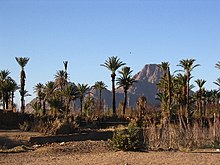
The climate of the Sahara has undergone enormous variation between wet and dry over the last few hundred thousand years.[15] During the last glacial period, the Sahara was even bigger than it is today, extending south beyond its current boundaries.[16] The end of the glacial period brought more rain to the Sahara, from about 8000 BC to 6000 BC, perhaps due to low pressure areas over the collapsing ice sheets to the north.[17]
Once the ice sheets were gone, northern Sahara dried out. But in southern Sahara, the drying trend was soon counteracted by the monsoon, which brought rain further north than it does today. The monsoon is due to heating of air over the land during summer. The hot air rises and pulls in cool, wet air from the ocean, which causes rain. Thus, though it seems counterintuitive, the Sahara was wetter when it received more solar insolation in the summer. This was caused by a stronger tilt in Earth's axis of orbit than today, and perihelion occurred at the end of July.[18]
By around 3400 BC, the monsoon retreated south to approximately where it is today,[19] leading to the gradual desertification of the Sahara.[20] The Sahara is now as dry as it was about 13,000 years ago.[15] These conditions are responsible for what has been called the Sahara pump theory.
The Sahara has one of the harshest climates in the world. The prevailing north-easterly wind often causes the sand to form sand storms and dust devils.[21] Half of the Sahara receives less than 2 centimetres (0.79 in) of rain per year, and the rest receives up to 10 cm (3.9 in) per year.[22] The rainfall happens very rarely, but when it does it is usually torrential when it occurs after long dry periods, which can last for years.
The southern boundary of the Sahara, as measured by rainfall, was observed to both advance and retreat between 1980 and 1990. As a result of drought in the Sahel, the southern boundary moved south 130 kilometres (81 mi) overall during that period.[23]. Deforestation has also caused the Sahara to advance south in recent years, as trees and bushes continue to be used as fuel source.
Ecoregions
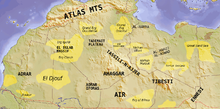
The Sahara comprises several distinct ecoregions, whose variations in temperature, rainfall, elevation, and soils harbor distinct communities of plants and animals. According to the World Wide Fund for Nature (WWF), the ecoregions of the Sahara include:
- Atlantic coastal desert: The coastal desert occupies a narrow strip along the Atlantic coast, where fog generated offshore by the cool Canary Current provides sufficient moisture to sustain a variety of lichens, succulents, and shrubs. It covers 39,900 square kilometers (15,400 square miles) in Western Sahara and Mauritania.[24]
- North Saharan steppe and woodlands: This ecoregion lies along the northern edge of the desert, next to the Mediterranean forests, woodlands, and scrub ecoregions of the northern Maghreb and Cyrenaica. Winter rains sustain shrublands and dry woodlands that form a transition between the Mediterranean climate regions to the north and the hyper-arid Sahara proper to the south. It covers 1,675,300 square kilometers (646,800 square miles) in Algeria, Egypt, Libya, Mauritania, Morocco, Tunisia, and Western Sahara.[25]
- Sahara desert: This ecoregion covers the hyper-arid central portion of the Sahara where rainfall is minimal and sporadic. Vegetation is rare, and this ecoregion consists mostly of sand dunes (erg, chech, raoui), stone plateaus (hamadas), gravel plains (reg), dry valleys (wadis), and salt flats. It covers 4,639,900 square kilometers (1,791,500 square miles) of Algeria, Chad, Egypt, Libya, Mali, Mauritania, Niger, and Sudan.[26]
- South Saharan steppe and woodlands: The South Saharan steppe and woodlands occupy a narrow band running east and west between the hyper-arid Sahara and the Sahel savannas to the south. Movements of the equatorial Intertropical Convergence Zone (ITCZ) bring summer rains during July and August which average 100 to 200 mm (3.9 to 7.9 in), but vary greatly from year to year. These rains sustain summer pastures of grasses and herbs, with dry woodlands and shrublands along seasonal watercourses. The ecoregion covers 1,101,700 square kilometers (425,400 square miles) in Algeria, Chad, Mali, Mauritania, and Sudan.[27]
- West Saharan montane xeric woodlands: Several volcanic highlands in the western portion of the Sahara provide a cooler, moister environment that supports Saharo-Mediterranean woodlands and shrublands. The ecoregion covers 258,100 square kilometers (99,700 square miles), mostly in the Tassili n'Ajjer of Algeria, with smaller enclaves in the Aïr of Niger, the Dhar Adrar of Mauritania, and the Adrar des Iforas of Mali and Algeria.[28]
- Tibesti-Jebel Uweinat montane xeric woodlands: The Tibesti and Jebel Uweinat highlands foster higher, more regular rainfall and cooler temperatures, which support woodlands and shrublands of palms, acacias, myrtle, oleander, Tamarix, and several rare and endemic plants. The ecoregion covers 82,200 square kilometers (31,700 square miles) in the Tibesti of Chad and Libya, and Jebel Uweinat on the border of Egypt, Libya, and Sudan.[29]
- Saharan halophytics: Seasonally-flooded saline depressions in the Sahara are home to halophytic, or salt-adapted, plant communities. The Saharan halophytics cover 54,000 square kilometers (20,800 square miles), including the Qattara and Siwa depressions in northern Egypt, the Tunisian salt lakes of central Tunisia, Chott Melghir in Algeria, and smaller areas of Algeria, Mauritania, and Western Sahara.[30].
- Tanezrouft: One of the harshest regions on Earth and the driest in the Sahara, contains no vegetation and very little life.
Fauna
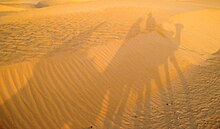
- Dromedary camels and goats are the most domesticated animals found in the Sahara. Because of its qualities of sobriety, endurance and speed, the dromedary is the favorite animal used by nomads.
- The Leiurus quinquestriatus (aka deathstalker) scorpion which can be 10 cm (3.9 in) long. Its venom contains large amounts of agitoxin and scyllatoxin and is very dangerous; however, a sting from this scorpion rarely kills a healthy adult.
- The monitor lizard. It has been suggested that the occasional habit of varanids to stand on their two hind legs and to appear to "monitor" their surroundings led to the original Arabic name waral ورل, which is translated to English as "monitor".[31]
- Sand vipers, which average less than 50 cm (20 in) in length. Many have a pair of horns, one over each eye. Active at night, they usually lie buried in the sand with only their eyes visible. Bites are painful, but rarely fatal.
- The African Wild Dog has some populations confirmed in the southern Sahara and is frequently misidentified as the cryptid Adjule.
- The fennec fox, pale fox and rüppell's fox, are omnivorous canids living in many parts of Sahara.
- The hyrax. It first appears in the fossil record over 40 million years ago, and for many millions of years hyraxes were the primary terrestrial herbivore in Africa.
- The ostrich which is a flightless bird native to Africa. They have become rare.
- The addax, a large white antelope, is a threatened species. Adapted to the desert, they can remain months without drinking, even a whole year.
- The Saharan cheetah lives in Algeria, Togo, Niger, Mali, Benin, and Burkina Faso. There remain less than 250 mature cheetahs which are very cautious, fleeing any human presence. The cheetah avoids the sun from April to October. It then seeks the shelter of shrubs such as balanites and acacias. They are unusually pale.[32][33]
There exist other animals in the Sahara (birds in particular) such as African Silverbill and Black-throated Firefinch among others.
History

Egyptians
By 6000 BC predynastic Egyptians in the southwestern corner of Egypt were herding cattle and constructing large buildings. Subsistence in organized and permanent settlements in predynastic Egypt by the middle of the 6th millennium BC centered predominantly on cereal and animal agriculture: cattle, goats, pigs and sheep. Metal objects replaced prior ones of stone. Tanning of animal skins, pottery and weaving are commonplace in this era also.[34] There are indications of seasonal or only temporary occupation of the Al Fayyum in the 6th millennium BC, with food activities centering on fishing, hunting and food-gathering. Stone arrowheads, knives and scrapers are common.[35] Burial items include pottery, jewelry, farming and hunting equipment, and assorted foods including dried meat and fruit. The dead are buried facing due west.[34] By 3400 BC, the Sahara was as dry as it is today, and it became a largely impenetrable barrier to humans, with only scattered settlements around the oases, but little trade or commerce through the desert. The one major exception was the Nile Valley. The Nile, however, was impassable at several cataracts, making trade and contact by boat difficult.
Nubians
During the Neolithic, before the onset of desertification, the central Sudan had been a rich environment supporting a large population ranging across what is now barren desert, like the Wadi el-Qa'ab. By the 5th millennium BC, the peoples who inhabited what is now called Nubia, were full participants in the "agricultural revolution," living a settled lifestyle with domesticated plants and animals. Saharan rock art of cattle and herdsmen found suggests the presence of a cattle cult like those found in Sudan and other pastoral societies in Africa today.[36] Megaliths found at Nabta Playa are overt examples of probably the world's first known Archaeoastronomy devices, predating Stonehenge by some 1000 years.[37] This complexity, as observed at Nabta Playa, and as expressed by different levels of authority within the society there, likely formed the basis for the structure of both the Neolithic society at Nabta and the Old Kingdom of Egypt.[38]
Phoenicians

The peoples of Phoenicia, who flourished between 1200-800 BC, created a confederation of kingdoms across the entire Sahara to Egypt. They generally settled along the Mediterranean coast, as well as the Sahara, among the peoples of Ancient Libya, who were the ancestors of peoples who speak Berber languages in North Africa and the Sahara today, including the Tuareg of the central Sahara.
The Phoenician alphabet seems to have been adopted by the ancient Libyans of north Africa, and Tifinagh is still used today by Berber-speaking Tuareg camel herders of the central Sahara.
Sometime between 633 BC and 530 BC, Hanno the Navigator either established or reinforced Phoenician colonies in Western Sahara, but all ancient remains have vanished with virtually no trace. (See History of Western Sahara.)
Greeks
By 500 BC, a new influence arrived in the form of the Greeks. Greek traders spread along the eastern coast of the desert, establishing trading colonies along the Red Sea coast. The Carthaginians explored the Atlantic coast of the desert. But the turbulence of the waters and the lack of markets never led to an extensive presence further south than modern Morocco. Centralized states thus surrounded the desert on the north and east; it remained outside the control of these states. Raids from the nomadic Berber people of the desert were a constant concern of those living on the edge of the desert.

Urban civilization
An urban civilization, the Garamantes, arose around this time in the heart of the Sahara, in a valley that is now called the Wadi al-Ajal in Fazzan, Libya.[15] The Garamantes achieved this development by digging tunnels far into the mountains flanking the valley to tap fossil water and bring it to their fields. The Garamantes grew populous and strong, conquering their neighbors and capturing many slaves (which were put to work extending the tunnels). The ancient Greeks and the Romans knew of the Garamantes and regarded them as uncivilized nomads. However, they traded with the Garamantes, and a Roman bath has been found in the Garamantes capital of Garama. Archaeologists have found eight major towns and many other important settlements in the Garamantes territory. The Garamantes civilization eventually collapsed after they had depleted available water in the aquifers, and could no longer sustain the effort to extend the tunnels still further into the mountains.[39]
Trans-Saharan trade

Following the Islamic conquest of North Africa in the seventh century CE, trade across the desert intensified. The kingdoms of the Sahel, especially the Ghana Empire and the later Mali Empire, grew rich and powerful exporting gold and salt to North Africa. The emirates along the Mediterranean Sea sent south manufactured goods and horses. From the Sahara itself, salt was exported. This process turned the scattered oasis communities into trading centres, and brought them under the control of the empires on the edge of the desert. A significant slave trade crossed the desert (See Arab slave trade).
This trade persisted for several centuries until the development in Europe of the caravel allowed ships, first from Portugal but soon from all Western Europe, to sail around the desert and gather the resources from the source in Guinea. The Sahara was rapidly remarginalized.
European imperialism
At the beginning of the 19th century, most of the northern Sahara, including most of present-day Algeria, Tunisia, Libya, and Egypt, was part of the Ottoman Empire. The Sahel and southern Sahara were home to several independent states.
European colonialism in the Sahara began in the 19th century. France conquered Algeria from the Ottomans in 1830, and French rule spread south from Algeria and eastwards from Senegal into the upper Niger to include present-day Algeria, Chad, Mali, Mauritania, Morocco (1912), Niger, and Tunisia (1881).
Egypt, under Muhammad Ali and his successors, conquered Nubia (1820-22), founded Khartoum (1823), and conquered Darfur (1874). Egypt, including the Sudan, became a British protectorate in 1882. Egypt and Britain lost control of the Sudan from 1882 to 1898 as a result of the Mahdist War. After its capture by British troops in 1898, the Sudan became a Anglo-Egyptian condominium.
Spain captured present-day Western Sahara after 1874. In 1912, Italy captured Libya from the Ottomans.
To promote the Roman Catholic religion in the desert, the Pope in 1868 appointed a delegate Apostolic of the Sahara and the Sudan; later in the 19th century his jurisdiction was reorganized into the Vicariate Apostolic of Sahara.
Modern times

Egypt became independent of Britain in 1936, although the Anglo-Egyptian Treaty of 1936 allowed Britain to keep troops in Egypt and maintained the British-Egyptian condominium in the Sudan. British military forces were withdrawn in 1954.
Most of the Saharan states achieved independence after World War II: Libya in 1951, Morocco, Sudan, and Tunisia in 1956, Chad, Mali, Mauritania, and Niger in 1960, and Algeria in 1962. Spain withdrew from Western Sahara in 1975, and it was partitioned between Mauritania and Morocco. Mauritania withdrew in 1979, but Morocco continues to hold the territory.
The modern era has seen a number of mines and communities develop to exploit the desert's natural resources. These include large deposits of oil and natural gas in Algeria and Libya and large deposits of phosphates in Morocco and Western Sahara.
A number of Trans-African highways have been proposed across the Sahara, including the Cairo-Dakar Highway along the Atlantic coast, the Trans-Sahara Highway from Algiers on the Mediterranean to Kano in Nigeria, the Tripoli-Cape Town Highway from Tripoli in Libya to Ndjamena in Chad, and the Cairo-Cape Town Highway which follows the Nile. Each of these highways is partially complete, with significant gaps and unpaved sections.
Peoples and languages
The Sahara is home to a number of peoples and languages. Arabic is the most widely spoken language in the Sahara, from the Atlantic to the Red Sea. Berber people are found from western Egypt to Morocco, including the Tuareg pastoralists of the central Sahara. The Beja live in the Red Sea Hills of southeastern Egypt and eastern Sudan. The Arabic, Berber, and Beja languages are part of the Afro-Asiatic language family.
Speakers of the Nilo-Saharan language family also inhabit the Sahara, including the Fur of Darfur in western Sudan and the Saharan languages of Niger, Chad and western Sudan, which includes the Kanuri, Tedaga, and Dazaga.
Countries in the Sahara
The following countries are either fully or partially covered by the Sahara.
See also
References
- Michael Brett and Elizabeth Frentess. The Berbers. Blackwell Publishers, 1996.
- Charles-Andre Julien. History of North Africa: From the Arab Conquest to 1830. Praeger, 1970.
- Abdallah Laroui. The History of the Maghrib: An Interpretive Essay. Princeton, 1977.
- Hugh Kennedy. Muslim Spain and Portugal: A Political History of al-Andalus. Longman, 1996.
- Richard W. Bulliet. The Camel and the Wheel. Harvard University Press, 1975. Republished with a new preface Columbia University Press, 1990.
Notes
- ^ MIT OpenCourseWare. (2005) "9-10 thousand Years of African Geology". Massachusetts Institute of Technology. Pages 6 and 13
- ^ Arthur N. Strahler and Alan H. Strahler. (1987) Modern Physical Geography–Third Edition. New York: John Wiley & Sons. Page 347
- ^ "Sahara." Online Etymology Dictionary. Douglas Harper, Historian. Accessed on June 25, 2007.
- ^ English-Arabic online dictionary
- ^ Discover Magazine, 2006-Oct.
- ^ National Geographic News, 2006-06-17.
- ^ Sahara Expanding, accessed on April 20, 2008
- ^ Sahara, accessed on April 20, 2008
- ^ http://www.csmonitor.com/2005/0801/p01s02-woaf.html Hunger is spreading in Africa, accessed on April 20, 2008
- ^ "Sahara desert" WWF Scientific Report [1]. Accessed December 30, 2007.
- ^ Wickens, Gerald E. (1998) Ecophysiology of Economic Plants in Arid and Semi-Arid Lands. Springer, Berlin. ISBN 978-3-540-52171-6
- ^ a b Grove, A.T., nicole (1958,2007). "The Ancient Erg of Hausaland, and Similar Formations on the South Side of the Sahara". The Geographical Journal. 124 (4): 528–533. doi:10.2307/1790942. Retrieved 2007-05-23.
{{cite journal}}: Check date values in:|year=(help)CS1 maint: multiple names: authors list (link) CS1 maint: year (link) - ^ a b Bisson, J. (2003). Mythes et réalités d'un désert convoité: le Sahara. L'Harmattan.Template:Fr icon
- ^ a b Walton, K. (2007). The Arid Zones. Aldine.
- ^ a b c Kevin White and David J. Mattingly (2006), Ancient Lakes of the Sahara, vol. 94, American Scientist, pp. 58–65
- ^ Christopher Ehret. The Civilizations of Africa. University Press of Virginia, 2002.
- ^ Fezzan Project — Palaeoclimate and environment, retrieved March 15, 2006.
- ^ "Geophysical Research Letters" Simulation of an abrupt change in Saharan vegetation in the mid-Holocene - July 15th, 1999
- ^ Sahara's Abrupt Desertification Started by Changes in Earth's Orbit, Accelerated by Atmospheric and Vegetation Feedbacks.
- ^ Kröpelin, Stefan (2008). "Climate-Driven Ecosystem Succession in the Sahara: The Past 6000 Years". Science. 320 (5877): 765–768. doi:10.1126/science.1154913. PMID 18467583.
{{cite journal}}: Cite has empty unknown parameter:|month=(help); External link in|title=|coauthors=ignored (|author=suggested) (help) - ^ Oxfam Cool Planet - the Sahara - access February 10, 2008
- ^ Tiempo Climate Newswatch: Climate Change and the Sahara
- ^ Expansion and contraction of the Sahara Desert between 1980 and 1990| Science 253: 299-301.
- ^ "Atlantic coastal desert" WWF Scientific Report [2]. Accessed December 29, 2007.
- ^ "North Saharan steppe and woodlands" WWF Scientific Report [3]. Accessed December 29, 2007.
- ^ "Sahara desert" WWF Scientific Report [4]. Accessed December 29, 2007.
- ^ "South Saharan steppe and woodlands" WWF Scientific Report [5]. Accessed December 29, 2007.
- ^ "West Saharan montane xeric woodlands" WWF Scientific Report [6]. Accessed December 29, 2007.
- ^ "Tibesti-Jebel Uweinat montane xeric woodlands" WWF Scientific Report [7]. Accessed December 29, 2007.
- ^ "Saharan halophytics" WWF Scientific Report [8]. Accessed December 29, 2007.
- ^ Pianka, E.R.; King, D.R. and King, R.A. 2004. Varanoid Lizards of the World. Indiana University Press.
- ^ http://news.bbc.co.uk/2/hi/science/nature/7905986.stm BBC News: " Rare cheetah captured on camera"
- ^ http://www.iucnredlist.org/details/221 The IUCN Red List of Threatened Species: Acinonyx jubatus ssp. hecki
- ^ a b Predynastic] (5,500–3,100 BC), Tour Egypt].
- ^ Fayum, Qarunian (Fayum B, about 6000–5000 BC?), Digital Egypt.
- ^ History of Nubia
- ^ PlanetQuest: The History of Astronomy - Retrieved on 2007-08-29
- ^ Late Neolithic megalithic structures at Nabta Playa - by Fred Wendorf (1998)
- ^ Keys, David. 2004. Kingdom of the Sands. Archaeology. Volume 57 Number 2, March/April 2004. Abstract retrieved March 13, 2006.
I hate you fat trick
External links
- About Sahara subsurface hydrology and planned usage of the aquifers
